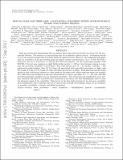How do stars gain their mass? A JCMT/SCUBA-2 transient survey of protostars in nearby star-forming regions
Abstract
Most protostars have luminosities that are fainter than expected from steady accretion over the protostellar lifetime. The solution to this problem may lie in episodic mass accretion—prolonged periods of very low accretion punctuated by short bursts of rapid accretion. However, the timescale and amplitude for variability at the protostellar phase is almost entirely unconstrained. In A James Clerk Maxwell Telescope/SCUBA-2 Transient Survey of Protostars in Nearby Star-forming Regions, we are monitoring monthly with SCUBA-2 the submillimeter emission in eight fields within nearby (<500 pc) star-forming regions to measure the accretion variability of protostars. The total survey area of ~1.6 deg2 includes ~105 peaks with peaks brighter than 0.5 Jy/beam (43 associated with embedded protostars or disks) and 237 peaks of 0.125–0.5 Jy/beam (50 with embedded protostars or disks). Each field has enough bright peaks for flux calibration relative to other peaks in the same field, which improves upon the nominal flux calibration uncertainties of submillimeter observations to reach a precision of ~2%–3% rms, and also provides quantified confidence in any measured variability. The timescales and amplitudes of any submillimeter variation will then be converted into variations in accretion rate and subsequently used to infer the physical causes of the variability. This survey is the first dedicated survey for submillimeter variability and complements other transient surveys at optical and near-IR wavelengths, which are not sensitive to accretion variability of deeply embedded protostars.
Citation
Herczeg , G J , Johnstone , D , Mairs , S , Hatchell , J , Lee , J-E , Bower , G C , Chen , H-R V , Aikawa , Y , Yoo , H , Kang , S-J , Kang , M , Chen , W-P , Williams , J P , Bae , J , Dunham , M M , Vorobiov , E I , Zhu , Z , Rao , R , Kirk , H , Takahashi , S , Morata , O , Lacaille , K , Lane , J , Pon , A , Scholz , A , Samal , M R , Bell , G S , Graves , S , Lee , E M , Parsons , H , He , Y , Zhou , J , Kim , M-R , Chapman , S , Drabek-Maunder , E , Chung , E J , Eyres , S P S , Forbrich , J , Hillenbrand , L A , Inutsuka , S , Kim , G , Kim , K H , Kuan , Y-J , Kwon , W , Lai , S-P , Lalchand , B , Lee , C W , Lee , C-F , Long , F , Lyo , A-R , Qian , L , Scicluna , P , Soam , A , Stamatellos , D , Takakuwa , S , Tang , Y-W , Wang , H & Wang , Y 2017 , ' How do stars gain their mass? A JCMT/SCUBA-2 transient survey of protostars in nearby star-forming regions ' , Astrophysical Journal , vol. 849 , no. 1 , 43 . https://doi.org/10.3847/1538-4357/aa8b62
Publication
Astrophysical Journal
Status
Peer reviewed
ISSN
0004-637XType
Journal article
Collections
Items in the St Andrews Research Repository are protected by copyright, with all rights reserved, unless otherwise indicated.

